Top 5 articles regarding nature biomimicry in 2011
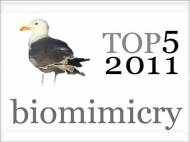 Among other news and articles we post in the bionics category, one of the most interesting subjects we cover there is biomimicry – imitating nature in man-made systems. Although it can be outperformed, nature still does provide inspiration for more efficient and environmentally friendly technologies. Bionics is becoming more increasingly used in design, materials science and process mimicking.
Among other news and articles we post in the bionics category, one of the most interesting subjects we cover there is biomimicry – imitating nature in man-made systems. Although it can be outperformed, nature still does provide inspiration for more efficient and environmentally friendly technologies. Bionics is becoming more increasingly used in design, materials science and process mimicking.
Here are the 5 most popular articles regarding biomimicry in 2011:
5. Plant sentinels able to detect pollution and explosives
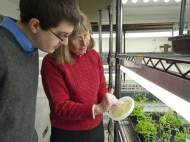 A group of researchers from the Colorado State University managed to make a computer-designed detection trait work in a plant by rewiring its natural signaling process. Once perfected, the technology could be used for a wide range of applications such as security in public places like airports or shopping malls, or monitoring for pollutants such as radon in a home.
A group of researchers from the Colorado State University managed to make a computer-designed detection trait work in a plant by rewiring its natural signaling process. Once perfected, the technology could be used for a wide range of applications such as security in public places like airports or shopping malls, or monitoring for pollutants such as radon in a home.
They used a computer program to redesign naturally occurring proteins called receptors. These re-designed receptors specifically recognize a pollutant or explosive. When the plant detects such a substance, it activates an internal signal that causes the plant to lose its green color, turning the plants white. The plants do change their color back to green once the pollutant or explosive is absent. The initial or first-generation plants respond to an explosive in hours, but improvements are underway to reduce the response time to a few minutes.
4. Pitcher plant biomimicry leads to SLIPS – efficient liquid repelling coating
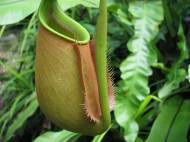 Inspired by pitcher plant, a group of applied scientists at Harvard University managed to create a material that repels just about any type of liquid, including blood and oil, and does so even while it is exposed to high pressure or freezing temperatures. Since it is carnivorous by nature, the ability to have a virtually frictionless surface inside its cupped leaf is crucial for its ability to capture insects or small frogs.
Inspired by pitcher plant, a group of applied scientists at Harvard University managed to create a material that repels just about any type of liquid, including blood and oil, and does so even while it is exposed to high pressure or freezing temperatures. Since it is carnivorous by nature, the ability to have a virtually frictionless surface inside its cupped leaf is crucial for its ability to capture insects or small frogs.
Instead using air-filled nanostructures to repel water, the pitcher plant locks in a layer of water and uses it as a slick coating. Inspired by this ability, the scientists devised a method to create slippery surfaces by infusing a nano/microstructured porous material with a lubricating fluid. The method is used to create Slippery Liquid-Infused Porous Surfaces (SLIPS) which are capable to repel a wide variety of liquids and solids.
3. Black ghost knifefish biomimicry inspired GhostBot robot
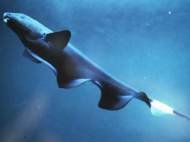 Researchers at Northwestern University have created a robotic fish that can move from swimming forward and backward to swimming vertically almost instantaneously by using a ribbon-like fin inspired by the black ghost knifefish – a night fish that lives in rivers of the Amazon basin. It hunts for prey using a weak electric field around its entire body and moves with a ribbon-like fin on the underside of its body.
Researchers at Northwestern University have created a robotic fish that can move from swimming forward and backward to swimming vertically almost instantaneously by using a ribbon-like fin inspired by the black ghost knifefish – a night fish that lives in rivers of the Amazon basin. It hunts for prey using a weak electric field around its entire body and moves with a ribbon-like fin on the underside of its body.
The fish only uses one traveling wave along the fin during horizontal motion (forward or backward depending on the direction on the wave), and it uses two waves while moving vertically. One of these moves from head to tail, and the other moves tail to head. The two waves collide and stop at the center of the fin. The robot they made mimics this movement and it has an electrosensory system that works similar to knifefish’s.
2. Mimosa biomimicry inspires new adaptive structures
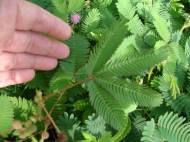 The Mimosa is among the plant varieties that exhibit specialized “nastic motions” – movements noticeable in real time with the naked eye. Its capability to fold its leaves when touched is inspiring a new class of adaptive structures designed to twist, bend, stiffen and even heal themselves. The flow of water in plant’s cells which enables the plant to fill or empty some of its cells with water. These microscopic shifts allow the plants to move and change shape on a larger scale.
The Mimosa is among the plant varieties that exhibit specialized “nastic motions” – movements noticeable in real time with the naked eye. Its capability to fold its leaves when touched is inspiring a new class of adaptive structures designed to twist, bend, stiffen and even heal themselves. The flow of water in plant’s cells which enables the plant to fill or empty some of its cells with water. These microscopic shifts allow the plants to move and change shape on a larger scale.
Researchers at University of Michigan and Penn State University are replicating the mechanisms with artificial cells. Currently, their artificial cells are palm-size and larger, but they’re trying to minify them by using microstructures and nanofibers to construct them. They’re also exploring how to replicate the mechanisms by which plants heal themselves.
1. Festo SmartBird mechanical bird inspired by herring gull
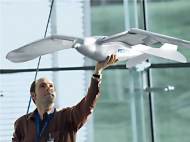 Inspired by the herring gull flight, the engineers of Festo’s Bionic Learning Network came up with SmartBird – an ultralight but powerful flight model with excellent aerodynamic qualities and extreme agility. The folks from Festo have already used biomimicry to develop similar products in the past, but the focus of this research is on energy-efficiency and conservation of resources.
Inspired by the herring gull flight, the engineers of Festo’s Bionic Learning Network came up with SmartBird – an ultralight but powerful flight model with excellent aerodynamic qualities and extreme agility. The folks from Festo have already used biomimicry to develop similar products in the past, but the focus of this research is on energy-efficiency and conservation of resources.
It is capable to take off autonomously and lift-up in the air by means of its flapping wings alone, without the aid of other devices to provide lift.









Leave your response!